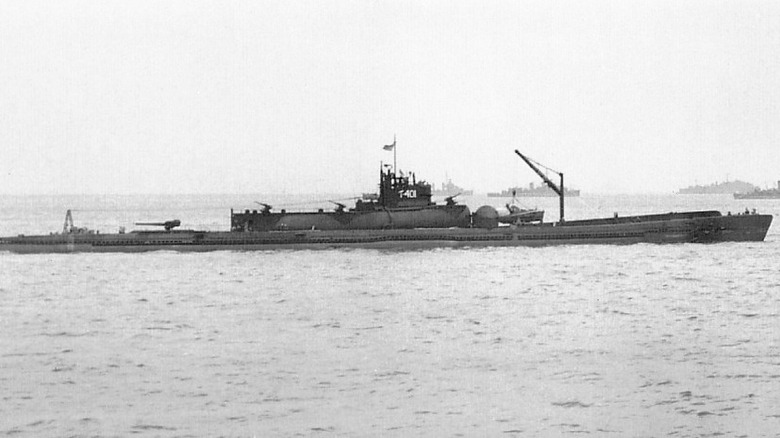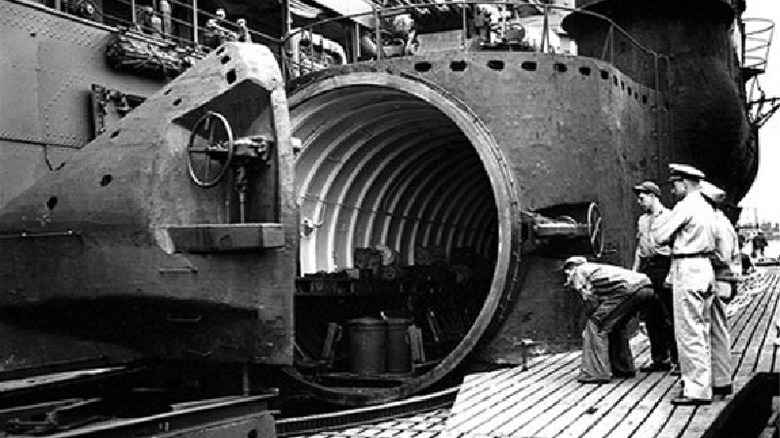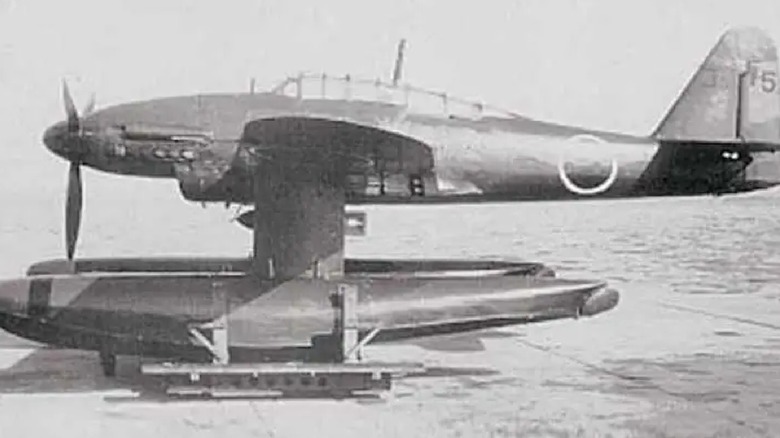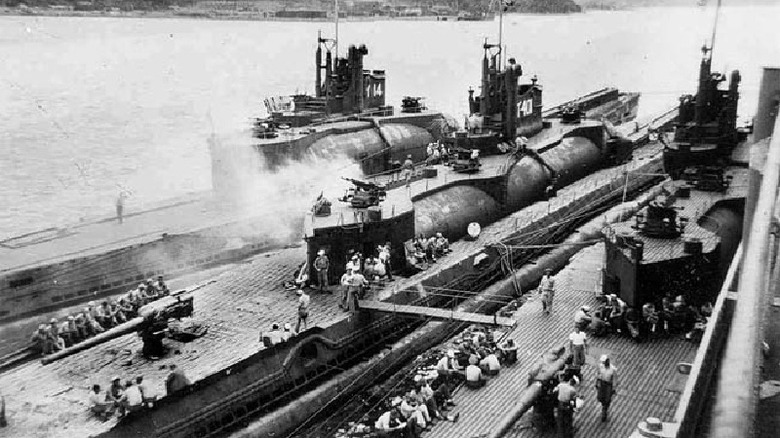The Story Of The I-400: Japan's Submarine Aircraft Carrier
At the time of World War II, American submarines were no longer than 312 feet with a beam of 27 feet. So, you can imagine America's surprise when two U.S. destroyers picked up a Japanese submarine on radar in August 1945 larger than any submarine they had ever seen. Not only was it the largest sub at the time, it was larger than both destroyers. A day later, Lieutenant Commander Stephen L. Johnson and his crew aboard the Balao-class submarine, USS Segundo, were equally surprised to find a similar vessel. The submarines were a part of the Japanese Sen Toku I-400-class submarine, which could have easily been two of the most legendary submarines of WW2.
Unlike Japan's dwarf submarines of World War II, the I-400 subs were 400 feet long and 39 feet wide, with a surface speed of 19 knots. The I-400 and her sister ship, the I-401, could stay out at sea for an impressive four months or travel one and a half times around the planet (or 37,500 miles) before needing to refuel. A feat no other sub at the time could accomplish. What truly made these vessels stand out, however, was their ability to carry aircraft.
When the U.S. forces captured both submarines, they discovered a large open and empty space that they assumed was used for storage. Oh, how close they were. That space was the hangar used to hold and transport planes, making them the first aircraft carrier that could travel underwater.
Why were the I-400s created?
Who might come up with such a unique design for a submarine? None other than the mind behind the infamous December 7, 1941, attack on Pearl Harbor, Admiral Isoroku Yamamoto, commander of Japan's Combined Fleet. He was concerned about what would happen to Japan after America got its bearings following the Pearl Harbor attack. He decided that a series of surprise attacks would be the best way for Japan to pull a victory out of the war. However, America wasn't going to be caught off-guard easily after what happened in Hawaii, so Yamamoto devised the submarine aircraft carrier idea as a means to get close to American cities without being detected.
Japan had used something similar to the I-400 in the past, except it carried floatplanes and only one plane fit in its hangar. Yamamoto wanted to improve on the idea, giving each sub two attack planes. The difficult part was getting the plane to land back in the submarine, so the plan skipped over that little detail. Instead, the pilot and their radioman would conduct their mission and fly back toward the sub, but instead of landing, they would eject from the plane altogether and wait for the sub to pick them up.
The initial targets for these submarines were going to be New York City and Washington D.C. However, once focus had to be contained to defending their homeland, the Japanese wanted to target the Panama Canal, as it would cripple America's ability to get reinforcements from the Atlantic to the Pacific.
Types of planes on the I-400
The I-400s needed a specialized aircraft in order to fit within the confines of a submerged hangar. Thus, the planes used for the submarine aircraft carriers were created from scratch. The product of the design, called the Aichi M6A1 Seiran, was a floatplane that could fold its wings, tail fins, and horizontal stabilizers. The original plan envisioned the plane without any sort of landing gear, but reason saw that using detachable floats would let the planes return to the sub and conduct another attack mission.
Without the floats equipped, the Seiran could reach speeds of 348 mph. If the plane kept the floats attached, it could fly as fast as 295 mph. The plane's compact size limited what it could carry in the way of weapons. In addition to the 13 mm machine gun for the radioman to use, the Serian could be armed with either a Type 91 torpedo, two 551-pound bombs, or one 1,874-pound bomb.
Details of the Seiran were so closely guarded that enemy forces knew next to nothing about its development. While nobody ever created an English code name for the aircraft, declassified documents eventually revealed that allied forces did have data on the Seiran. In fact, the documents revealed that the plane was intended "for submarine use," which could mean that higher-ups knew about the I-400s before the navy ever laid eyes on them. Having never been deployed on a mission, these are one of the rarest aircraft in history.
What happened to the I-400 submarines?
Eventually, the plan to attack the Panama Canal was sacked in favor of attacking the U.S. Navy base on Ulithi Atoll. However, the sailors aboard the vessels received conflicting orders after the nuclear bombings of Hiroshima and Nagasaki. One order came from the emperor, telling all Japanese warriors to surrender, while another order came from high-ranking officials ordering all submarines to continue with their previously planned missions. Just hours before the planned attack on Ulithi, an official command came in that directed the subs to the base in Kure. On its way to the designated port, the I-401 encountered the USS Segundo while the I-400 came across the two destroyers.
They surrendered without contention, but not before dumping the Seiran planes into the ocean, firing off their torpedoes, and burning all documents to prevent the Americans from getting anything of value. The I-400 subs were valuable enough and led to the creation of modern-day ballistic missile submarines. The Soviet Union got word that the Americans had possession of these unique vessels and wanted a chance to inspect them for themselves. The relationship between America and the USSR quickly soured after the war. Rather than letting the ingenuity of the Japanese fall into the hands of their former allies, America scuttled the I-400s.
The I-400 rested undisturbed 2,300 feet under the ocean off the coast of O'ahu until the Hawaiʻi Undersea Research Laboratory (HURL) discovered it in 2013.



